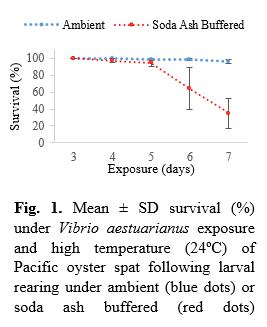IMPACTS OF SEAWATER pH BUFFERING ON LARVAL PACIFIC OYSTERS AND REPERCUSSIONS FOR SUSCEPTIBILITY OF LATER LIFE STAGES TO SUMMER MORTALITY STRESSORS
Ocean acidification and the resulting lowered aragonite saturation state of seawater have been linked to high levels of larval mortality in commercial Pacific oyster hatcheries. In response, many major oyster-seed producers along North America’s west coast have resorted to seawater pH buffering via the addition of soda ash. Whilst this may improve survival during larval stages, the repercussions of larval rearing under soda ash conditions for later life stages, particularly under stressor conditions, remain unknown. At the same time, shellfish growers who rely on seed from these hatcheries continue to observe high levels of summer mortality in commercial oyster stocks despite concentrated research efforts to pinpoint a cause and develop solutions.
In order to investigate the potential impacts of soda ash buffering on larvae and knock-on effects for later life stages, in terms of susceptibility to summer mortality stressors, Pacific oysters were reared under soda ash pH-buffered or ambient pH seawater conditions for the first 24 hours of development. At one day post-fertilization, all larvae were placed under ambient pH conditions for the remainder of the larval developmental period. Larval survival, growth, microbiome, and immune status were assessed across development. Spat (3-month) and adult (18-month) oysters arising from the larval run were used in laboratory-based challenge experiments to investigate carry-over effects to later life stages during stress events. Survival and immune status were assessed over 3–7-day exposures to the pathogenic bacterium Vibrio aestuarianus under high temperature (24°C).
Buffering resulted in an altered larval microbiome and animals reared under soda ash conditions as larvae showed increased mortality, as both spat (Fig. 1) and adults, compared to those reared in non-buffered seawater. Results suggest that impacts to the larval microbiome may compromise later life stages. We propose that while soda ash buffering may serve as a short-term solution for hatcheries, it may also be contributing to summer mortality of Pacific oysters.
